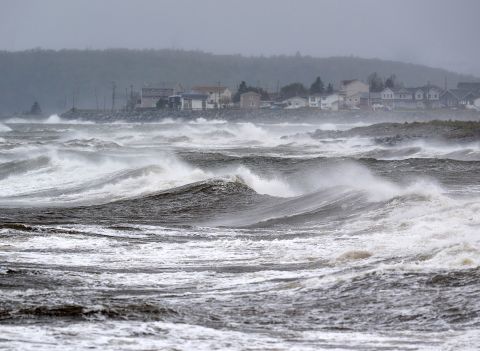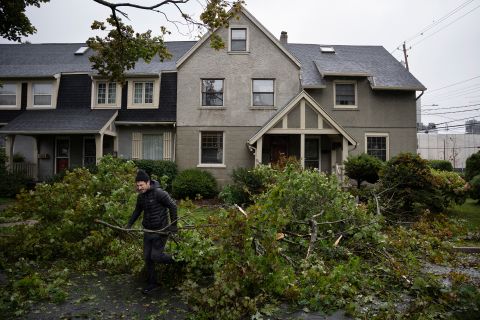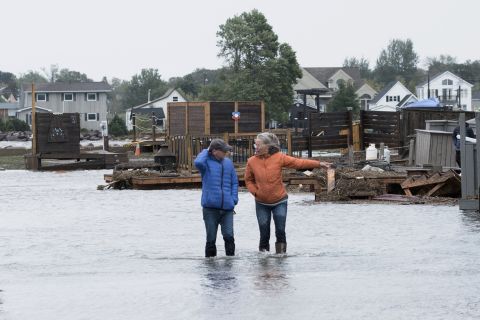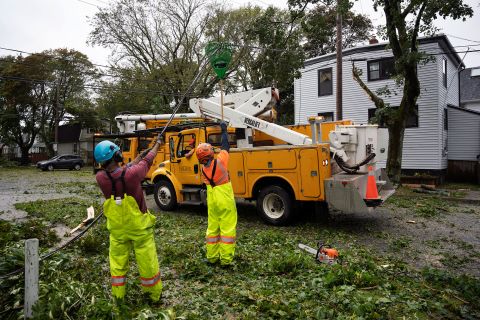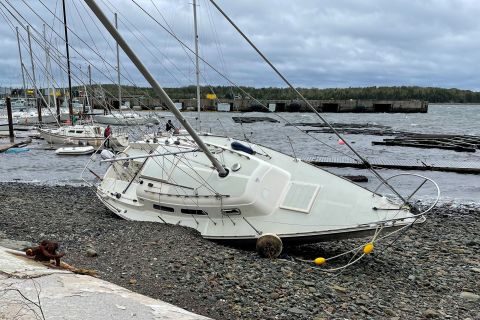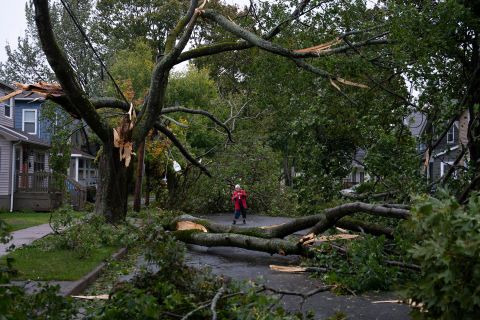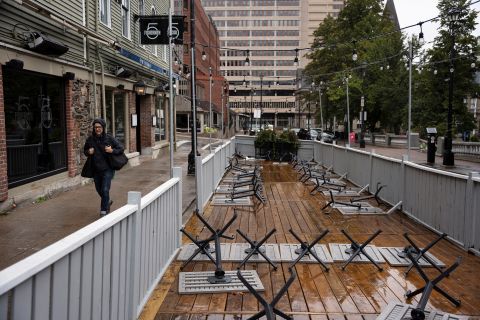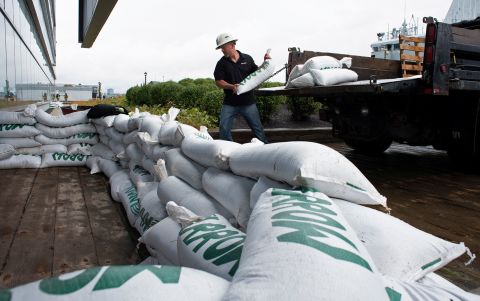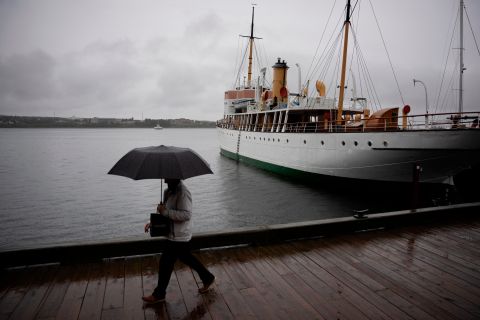Editor’s Note: Affected by the storm? Use CNN’s lite site for low bandwidth.
CNN
—
After making landfall in Nova Scotia on Saturday, Fiona swept across Canada’s eastern seaboard as a hurricane, with high winds and storm surges sweeping the region, leaving hundreds of thousands of people without power and washing away or collapsing some coastal homes.
Fiona, now a post-tropical cyclone, continued to weaken slowly Saturday night until late into the night as it moved away from the coastal town of Channel-Port aux Basques in Newfoundland and Labrador, where the storm left a devastating trace. Images from the province on Saturday morning showed some coastal houses in the area collapsing and some top structures falling into the sea or surrounded by floodwaters.
In Channel-Port aux Basques, homes were swept away, Mayor Brian Barton said in a Facebook video Saturday. Large waves reaching Nova Scotia’s east coast and southwest Newfoundland caused “severe coastal flooding” in the town, the Canadian Hurricane Centre said Saturday night.
Authorities in the province declared a state of emergency for the town on Saturday morning amid “multiple electrical fires, residential flooding and washing.”
René Roy, editor-in-chief of the local news publication Wreckhouse Press, described a massacre in the storm: trees uprooted, at least eight nearby houses disappeared in the violent storm surge, floating huts, a boat washed ashore by floodwaters The center of the playground.
“I’ve been through Hurricane Juan, and compared to this monster, it was a foggy day,” Roy, 50, told CNN. Hurricane Juan struck the Canadian coast as a Category 2 storm in 2003, destroying power lines and trees and causing widespread damage. “What’s happening here is surreal,” Roy added.
Roy told CNN he had been evacuated from his home and was staying with a cousin who lives in Heights. He didn’t know if his home was still standing on Saturday night when paramedics prevented him from driving over to check. It is unsafe to do so, they warn.
A photo by another area resident, Terry Osmond, shows The collapsed buildings of Channel-Port aux Basques were surrounded by sea water from the shoreline, and splintered wood and other debris were scattered throughout the town.
“Never in my life have I had so much destruction…in our region,” Osmond, 62, wrote to CNN.
A woman in the town was rescued from the water Saturday afternoon after a house collapsed, RCMP said. She was taken to hospital; the extent of her injuries is not yet known, police said.
Video posted by Pius Scott on Facebook showed several buildings being blown up about 30 minutes east. Houses – or parts of them – collapsed in piles, with debris scattered on the ground and in the sea.
Canadian Prime Minister Justin Trudeau said Saturday afternoon that the government was assessing damage from the storm, but officials had already begun to help affected communities, including granting Nova Scotia’s request for federal aid. Trudeau said the Canadian Armed Forces will also be deployed to the area to assist with damage assessment and cleanup efforts.
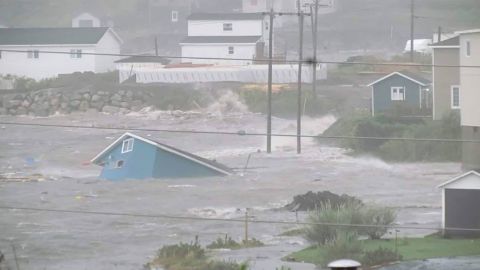
Meanwhile, more than 400,000 customers in Atlantic Canada remained in the dark Saturday night, including more than 290,000 in Nova Scotia and more than 85,000 in Prince Edward Island, according to Poweroutage.com.
Restoring power is one of officials’ top priorities, Nova Scotia Premier Tim Houston said at a news conference Saturday, describing “appalling” damage across the province, including to roads Washed-out neighborhoods, power lines removed.
But Nova Scotia Power President and CEO Peter Gregg said the weather conditions in many areas on Saturday night were still too severe for crews to begin assessing and repairing the damage. More than 900 power technicians are on their way to the area, but with parts of the province still experiencing storms, Greg added that some customers may experience power outages for several days.
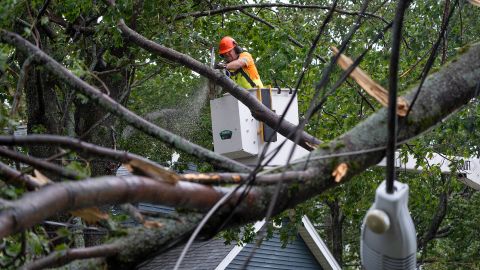
The storm made landfall in darkness early Saturday as a powerful post-tropical cyclone between Canso and Gasboro in eastern Nova Scotia and passed over the province’s Cape Breton Island. Officials in the Cape Breton region declared a state of emergency and asked people to shelter in place.
On Saturday night, the Cape Breton regional municipality said the ongoing telecommunications problems posed challenges and urged residents to stay in safe shelters as roads were littered with downed trees and power lines, making it unsafe to drive. Officials said emergency workers were working to help displaced residents.
West of the landfall, in the Nova Scotia capital Halifax, the roof of an apartment complex collapsed, forcing about 100 people to shelter, Mayor Mike Savage told CNN on Saturday.
“The intensity of this storm is breathtaking,” Savage later told a news conference Saturday. “It turns out that everything was as expected.”
Officials in Halifax said the risk of strong winds and coastal flooding remained for the rest of the day Saturday afternoon, and urged residents to stay off the road while cleanup efforts were underway.
Police in Charlottetown, Prince Edward Island tweet Photos of the damage, including the collapsed ceiling of the house.
“The situation is like nothing we’ve ever seen,” Charlottetown police tweeted earlier Saturday.
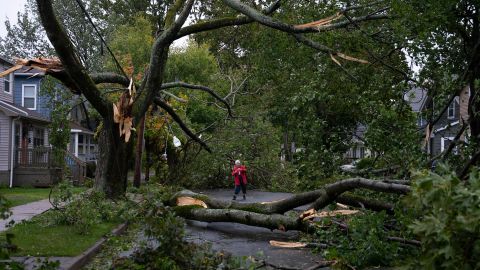
Fiona continued to impact parts of Atlantic Canada and eastern Quebec with strong winds and damaging storm surge Saturday night, but conditions are expected to improve in Cape Breton and Prince Edward Island and later Madeleine Island and southwestern Newfoundland. , said the Hurricane Center.
St. Lawrence and Newfoundland, coastal flooding still poses a threat to eastern Nova Scotia, Prince Edward Island including Northumberland Strait, Madeleine Island and southwestern Newfoundland, the center added.
“There may also be some coastal flooding in St. Petersburg. Lawrence Estuary and Quebec’s Lower North Shore,” it said.
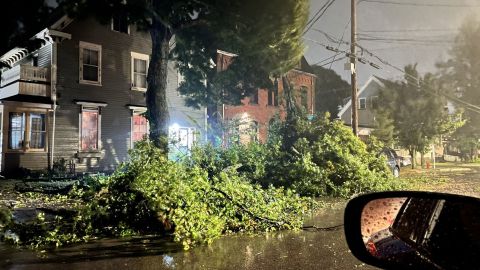
High winds and storms are expected to continue blowing across parts of Atlantic Canada until early Sunday, the National Hurricane Center said Saturday night.
Strong hurricane winds Saturday morning Reported speeds are typically 70 to 95 mph (110 to over 150 km/h) in parts of Canadian maritime. According to Environment Canada, the maximum wind gust in Alisag, Nova Scotia was 111 mph (179 km/h) as of mid-morning.
Forecasters said rainfall totals could be as high as 10 inches in some places and severe flooding could occur.
The storm battered islands in the Caribbean and Atlantic earlier this week, killing at least five people and leaving millions without power.
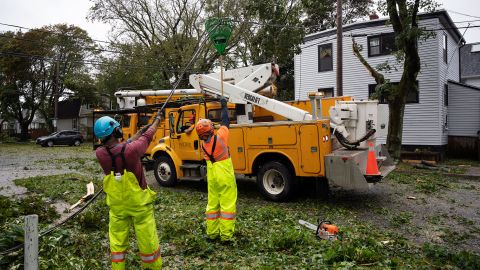
Fiona became a Category 4 storm over the Atlantic Ocean early Wednesday after passing the Turks and Caicos Islands and continued into Friday afternoon, weakening as it approached Canada. It became posttropical before making landfall, which means the storm now has a cold core instead of a warm one. It doesn’t affect the storm’s ability to generate strong winds, heavy rain and storm surge, it just means that the internal mechanics of the storm have changed.
Fiona has potential Becoming the Canadian version of Superstorm Sandy, Canadian Hurricane Centre manager Chris Fogarty said before Fiona hit. Sandy affected 24 states and the entire East Coast in 2012, causing an estimated $78.7 billion in damage.
The unofficial barometric pressure recorded on Saturday was 931.6 mb On Hart Island, this would make Fiona Canada’s lowest-pressure landfall storm on record, according to the Canadian Hurricane Centre.
